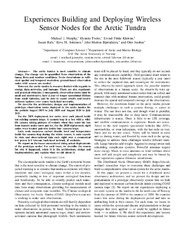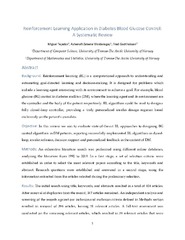Artikler, rapporter og annet (informatikk): Recent submissions
Now showing items 281-300 of 486
-
Experiences Building and Deploying Wireless Sensor Nodes for the Arctic Tundra
(Journal article; Tidsskriftartikkel, 2021-08-02)The arctic tundra is most sensitive to climate change. The change can be quantified from observations of the fauna, flora and weather conditions. To do observations at sufficient spatial and temporal resolution, ground-based observation nodes with sensors are needed. However, the arctic tundra is resource-limited with regards to energy, data networks, and humans. There are also regulatory and practical ... -
Opportunities for thermal energy storage in Longyearbyen
(Research report; Forskningsrapport, 2021-07-02)Energy storage is needed in Longyearbyen to enable a transition to local renewable energy sources. As heating accounts for more than half the energy use in Longyearbyen, affordable large-scale thermal storage is a good option. We investigate the opportunities for hot water, molten salt and hot rocks storage systems using a techno-economic optimisation model for the Longyearbyen energy system. -
Accountable Human Subject Research Data Processing using Lohpi
(Conference object; Konferansebidrag, 2021-06)In human subject research, various data about the studied individuals are collected. Through re-identification and statistical inferences, this data can be exploited for interests other than the ones the subjects initially consented to. Such exploitation must be avoided to maintain trust with the researched population. We argue that keeping data-access policies up-to-date and building accountability ... -
Engaging Social Media Users with Health Education and Physical Activity Promotion
(Journal article; Tidsskriftartikkel; Peer reviewed, 2021)Health-dedicated groups on social media provide different contents and social support to their peers. Our objective is to analyze users’ engagement with health education and physical activity promotion posts according to the expressed social support and social media. All health education and physical activity promotion posts on Facebook, Twitter, and Instagram during 2017–2019 by a diabetes association ... -
Highly efficient and scalable framework for high-speed super-resolution microscopy
(Journal article; Tidsskriftartikkel; Peer reviewed, 2021-07-05)The multiple signal classification algorithm (MUSICAL) is a statistical super-resolution technique for wide-field fluorescence microscopy. Although MUSICAL has several advantages, such as its high resolution, its low computational performance has limited its exploitation. This paper aims to analyze the performance and scalability of MUSICAL for improving its low computational performance. We first ... -
Behavioural change in green transportation: Micro-economics perspectives and optimization strategies
(Journal article; Tidsskriftartikkel; Peer reviewed, 2021-06-22)The increasing demand for Electric Vehicle (EV) charging is putting pressure on the power grids and capacities of charging stations. This work focuses on how to use indirect control through price signals to level out the load curve in order to avoid the power consumption from exceeding these capacities. We propose mathematical programming models for the indirect control of EV charging that aim at ... -
Preliminary Evaluation of a mHealth Coaching Conversational Artificial Intelligence for the Self-Care Management of People with Sickle-Cell Disease
(Journal article; Tidsskriftartikkel; Peer reviewed, 2020)Adherence to the complex set of recommended self-care practices among people with Sickle-Cell Disease (SCD) positively impacts health outcomes. However, few patients possess the required skills (i.e. disease-specific knowledge, adequate levels of self-efficacy). Consequently, adherence rates remain low and only 1% of patients are empowered enough to master the self-care practices. Health coaching ... -
Up-to-the-Minute Privacy Policies via Gossips in Participatory Epidemiological Studies
(Journal article; Tidsskriftartikkel; Peer reviewed, 2021-05-13)Researchers and researched populations are actively involved in participatory epidemiology. Such studies collect many details about an individual. Recent developments in statistical inferences can lead to sensitive information leaks from seemingly insensitive data about individuals. Typical safeguarding mechanisms are vetted by ethics committees; however, the attack models are constantly evolving. ... -
Toward a Conversational Agent to Support the Self-Management of Adults and Young Adults With Sickle Cell Disease: Usability and Usefulness Study
(Journal article; Tidsskriftartikkel; Peer reviewed, 2021-01-29)Sickle cell disease (SCD) is the most common genetic blood disorder in the world and affects millions of people. With aging, patients encounter an increasing number of comorbidities that can be acute, chronic, and potentially lethal (e.g., pain, multiple organ damages, lung disease). Comprehensive and preventive care for adults with SCD faces disparities (e.g., shortage of well-trained providers). ... -
Photoperiod-dependent developmental reprogramming of the transcriptional response to seawater entry in Atlantic salmon (Salmo salar)
(Journal article; Tidsskriftartikkel; Peer reviewed, 2021-03-12)The developmental transition of juvenile salmon from a freshwater resident morph (parr) to a seawater (SW) migratory morph (smolt), known as smoltification, entails a reorganization of gill function to cope with the altered water environment. Recently, we used RNAseq to characterize the breadth of transcriptional change which takes place in the gill in the FW phase of smoltification. This highlighted ... -
Educating the energy informatics specialist: opportunities and challenges in light of research and industrial trends
(Journal article; Tidsskriftartikkel; Peer reviewed, 2021-05-30)Contemporary energy research is becoming more interdisciplinary through the involvement of technical, economic, and social aspects that must be addressed simultaneously. Within such interdisciplinary energy research, the novel domain of energy informatics plays an important role, as it involves different disciplines addressing the socio-techno-economic challenges of sustainable energy and power ... -
A multihorizon approach for the reliability oriented network restructuring problem, considering learning effects, construction time, and cables maintenance costs
(Journal article; Tidsskriftartikkel; Peer reviewed, 2020-12-29)This paper presents a techno-economic optimisation tool to study how the power system expansion decisions can be taken in a more economical and efficient way, by minimising the consequent costs of network reinforcement and reconfiguration. Analyses are performed to investigate how the network reinforcement and reconfiguration should be planned, within a time horizon of several years, by continuously ... -
A novel algorithm to detect non-wear time from raw accelerometer data using deep convolutional neural networks
(Journal article; Tidsskriftartikkel; Peer reviewed, 2021-04-23)To date, non-wear detection algorithms commonly employ a 30, 60, or even 90 mins interval or window in which acceleration values need to be below a threshold value. A major drawback of such intervals is that they need to be long enough to prevent false positives (type I errors), while short enough to prevent false negatives (type II errors), which limits detecting both short and longer episodes of ... -
Reinforcement learning application in diabetes blood glucose control: A systematic review
(Journal article; Tidsskriftartikkel; Peer reviewed, 2020-02-21)<p>Background: Reinforcement learning (RL) is a computational approach to understanding and automating goal-directed learning and decision-making. It is designed for problems which include a learning agent interacting with its environment to achieve a goal. For example, blood glucose (BG) control in diabetes mellitus (DM), where the learning agent and its environment are the controller and the body ... -
Consumer-Based Activity Trackers as a Tool for Physical Activity Monitoring in Epidemiological Studies During the COVID-19 Pandemic: Development and Usability Study
(Journal article; Tidsskriftartikkel; Peer reviewed, 2021-04-23)Background: Consumer-based physical activity trackers have increased in popularity. The widespread use of these devices and the long-term nature of the recorded data provides a valuable source of physical activity data for epidemiological research. The challenges include the large heterogeneity between activity tracker models in terms of available data types, the accuracy of recorded data, and how ... -
Integration of solar latent heat storage towards optimal small-scale combined heat and power generation by Organic Rankine Cycle
(Journal article; Tidsskriftartikkel; Peer reviewed, 2020-03-16)Thermal energy and distributed electricity demand are continuously increased in areas poorly served by a centralized power grid. In many cases, the deployment of the electricity grid is not economically feasible. Small-scale Organic Rankine Cycle (ORC) appears as a promising technology that can be operated by solar energy, providing combined heat and power (CHP) generation. Additionally, thermal ... -
Features extraction of wind ramp events from a virtual wind park
(Journal article; Tidsskriftartikkel; Peer reviewed, 2020-11-26)In the European renewable energy portfolio, wind has a sizeable share in the total energy production. The Nordic and Baltic energy systems in particular are benefiting from wind energy to reach the greenhouse gas emissions reduction objectives set by the EU. The wind energy production varies with time, and this intermittent characteristic imposes a challenge for full utilization of renewable energy ... -
HyperKvasir, a comprehensive multi-class image and video dataset for gastrointestinal endoscopy
(Journal article; Tidsskriftartikkel; Peer reviewed, 2020-08-28)Artificial intelligence is currently a hot topic in medicine. However, medical data is often sparse and hard to obtain due to legal restrictions and lack of medical personnel for the cumbersome and tedious process to manually label training data. These constraints make it difficult to develop systems for automatic analysis, like detecting disease or other lesions. In this respect, this article ... -
Neural network based country wise risk prediction of COVID-19
(Journal article; Tidsskriftartikkel; Peer reviewed, 2020-09-16)The recent worldwide outbreak of the novel coronavirus (COVID-19) has opened up new challenges to the research community. Artificial intelligence (AI) driven methods can be useful to predict the parameters, risks, and effects of such an epidemic. Such predictions can be helpful to control and prevent the spread of such diseases. The main challenges of applying AI is the small volume of data and the ... -
Metastatic Breast Cancer and Pre-Diagnostic Blood Gene Expression Profiles—The Norwegian Women and Cancer (NOWAC) Post-Genome Cohort
(Journal article; Tidsskriftartikkel; Peer reviewed, 2020-10-15)Breast cancer patients with metastatic disease have a higher incidence of deaths from breast cancer than patients with early-stage cancers. Recent findings suggest that there are differences in immune cell function between metastatic and non-metastatic cases, even years before diagnosis. We have analyzed whole blood gene expression by Illumina bead chips in blood samples taken using the PAXgene blood ...


 English
English norsk
norsk


















